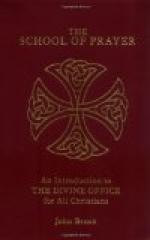The Prophet Daniel, a captive in Babylon, prayed thrice daily, his face turned to Jerusalem. The Israelites, captives in Babylon with Nehemias, “rose up and read in the book of the Law of the Lord their God, four times in the day, and four times they confessed and adored the Lord their God” (II. Esdras ix. 3). Hence, the Jewish day, made up as it was with sacrifices, libations, oblations, purifications, and public and private prayer, was a day of prayer. In these public meetings they sang God’s praises, sang of His glory and of His mercy. Sometimes they spoke with loving familiarity, sometimes they prayed on bended knee, sometimes they stood and pleaded with outstretched hands, pouring out the prayers inspired by God Himself.
In the New Law our Saviour is the model of prayer, the true adorer of His Father. He alone can worthily adore and praise because He alone has the necessary perfection. Night and day He set example to His followers. He warned them to watch and pray; He taught them how to pray; He gave them a form of prayer; He prayed in life and at death. His apostles, trained in the practices of the synagogue, were perfected by the example and the exhortations of Christ. This teaching and example are shown in effect when the assembled apostles were “at the third hour of the day” praying (Acts ii. 15); when about the sixth hour Peter went to pray (Acts x. 9). In the Acts of Apostles we see how Peter and John went at the ninth hour to the temple to pray. St. Paul in prison sang God’s praises at midnight, and he insists on his converts singing in their assembly psalms and hymns (Ephes. v. 19; Col. Iii. 16; I. Cor. xiv. 26).
What form did the public prayers, which we may call the divine office, take in the time of the Apostles? It is impossible to say. But it is certain 10 that there were public prayers, 20 that they were offered up daily in certain determined places and at fixed hours, 30 that these public prayers consisted principally of the Psalms, hymns, canticles, extracts from Sacred Scripture, the Lord’s Prayer, and probably the Creed, 40 that these public prayers varied in duration according to the will of the bishop or master who presided.
“The weekly commemoration of Christ’s resurrection, the yearly recurrence of the memory of the great facts of Christ’s life, the daily sanctification of the hours of the day, each led the Christian to draw upon the hours of the Psalter, and when, gradually, fixed hours for daily prayer passed beyond the home circle and with groups of ascetics entered the public churches, it was from the Psalter that the songs of praise were drawn, and from the Psalms were added a series of canticles, taken from the books of the Old and the New Testaments, and thus, long ages before any stereotyped arrangement of the Psalms existed, assigning particular Psalms to particular days or hours, the Psalms were feeding the piety of the faithful and teaching men to pray” (The




